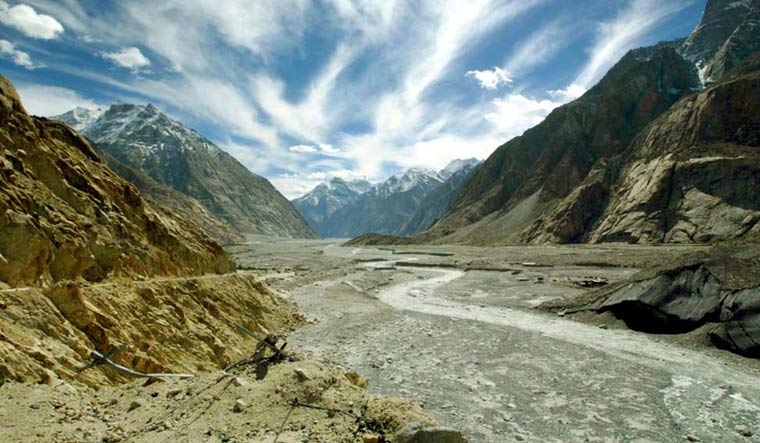Siachen Glacier—world's highest battlefield—is now open for tourists. Defence Minister Rajnath Singh made the announcement during his visit to Ladakh, along with Army chief Gen. Bipin Rawat, to inaugurate a strategically located bridge across the Shyok River which will provide an easy connectivity with the Daulat Beg Oldi sector along the Line of Actual Control (LAC) with China.
“The Siachen area is now open for tourists and tourism. From Siachen Base Camp to Kumar Post, the entire area has been opened for tourism purposes,” Singh said in a tweet. Better connectivity in Ladakh would certainly bring tourists in large numbers, he added.
Mountaineering expeditions were allowed in Siachen till 1984 before the region was militarized following machinations by Pakistan. The Siachen Glacier, which once used to be a demilitarized zone, came under the strategic control of India in 1984 following 'Operation Meghdoot'. The operation was launched by the Indian armed forces after Pakistan allowed a Japanese team to undertake an expedition to a strategic peak in the glacier. Siachen Glacier comes under Ladakh which recently got the status of a Union Territory.
Rajnath Singh claimed that with the decision to make Ladakh a separate Union Territory, the government has fulfilled a long-pending demand of the people. The decision will open new doors of development in the region, he said.
“Like the rest of the country, Ladakh will now become a destination for investment. There will also be a boost in revenue generation and employment opportunities for local people,” Rajnath added.
The minister said abrogation of Article 370 will put an end to terrorism and separatism which, since independence, have led to the killing of thousands of innocent people. The move will also strengthen human rights and help in empowering women of the area, he said.
While reiterating the government's commitment to bolster border infrastructure to effectively deal with any threats that undermine peace and tranquility in the country, the defence minister described Col Chewang Rinchen Setu as a symbol of the government’s resolve of positive change and all-round development of the nation. Sandwiched between strategic Karakoram and Chang Chenmo ranges, the Col Chewang Rinchen Setu is a 430-metre long bridge built at an altitude of about 15,000 feet using Micro Piling Technology. The construction has been completed in a record time of 15 months, the ministry of defence said in a statement.
Rajnath said the bridge not only connects Durbuk with Daulat Beg Oldie but also links the people of Ladakh and all interior areas of Jammu and Kashmir with the rest of the country. “Through initiatives like these, people of this region will have the opportunity to become part of India’s growth story,” Rajnath hoped.
“Keeping in view the current security situation, strengthening our borders is the need of the hour. Border area development is an integral part of our government’s plan and this bridge is a part of that strategy,” the minister said.
The Col Chewang Rinchen Setu was constructed by the Border Roads Organisation (BRO) at an altitude of 14,650 feet in the forward area of Ladakh region. Col Chewang Rinchen, born on November 11, 1931 at Sumur, Nubra Valley in Ladakh region, is known as the “Lion of Ladakh” for his extraordinary acts of courage in defending Leh and Partapur sector. He is one of the six armed forces personnel to have been awarded the Maha Vir Chakra, the second highest Indian Gallantry Award, twice.
Rajnath stated that India shares a cordial relation with China. "There are perceptional differences between both the countries on the boundary issue, but the issue has been handled with great maturity and responsibility. Both the countries have not allowed the situation to escalate or go out of hand,” he added.
His junior in the ministry, Shripad Naik, in July informed the parliament that a revised Long Term Roll on Works Plan of Border Roads Organisation for five years (2018-19 to 2022-23) had been formulated for construction/improvement of 272 roads of length 14,545 km in border areas.
“Out of these 272 roads, 61 roads of length 3323.57 km have been identified as strategic. Work has been completed on 2304.65 km and work on balance stretches is in progress,” Naik had stated in a written reply, adding that in addition to meeting the operational requirement, these roads on completion “would also enhance accessibility to border areas where the border infrastructure and forward connectivity is lacking.”



